“If there is something comforting – religious, if you want – about paranoia, there is still also anti-paranoia, where nothing is connected to anything, a condition not many of us can bear for long.” – Gravity’s Rainbow, Thomas Pynchon
Obfuscation is a balm. Paranoia or conspiracy or lamenting the tangled reasons and non-reasons and imagined reasons for the end of a relationship, thinking of the past, of ghosts – often these types of rabbit holes are comforting. As long as they don’t become sink holes. And often all can intertwine in a rambling interior narrative of connections and “what if?” thinking that busies your mind from what you’re frequently avoiding – pain. Wistful memories are a lot more soothing, even if they make you sad. In Paul Thomas Anderson’s Inherent Vice, hippie, stoner, romantic PI, Doc Sportello (Joaquin Phoenix) listens when his ex walks back into his life, and bringing a labyrinthian mystery, says, “It isn’t what you’re thinking, Doc.” He answers, “Don’t worry, thinking comes later.” It does, and sooner rather than later – thinking that becomes muddied and strange and absurd and hilarious and ominous and beautiful and ugly and, what does this mean?
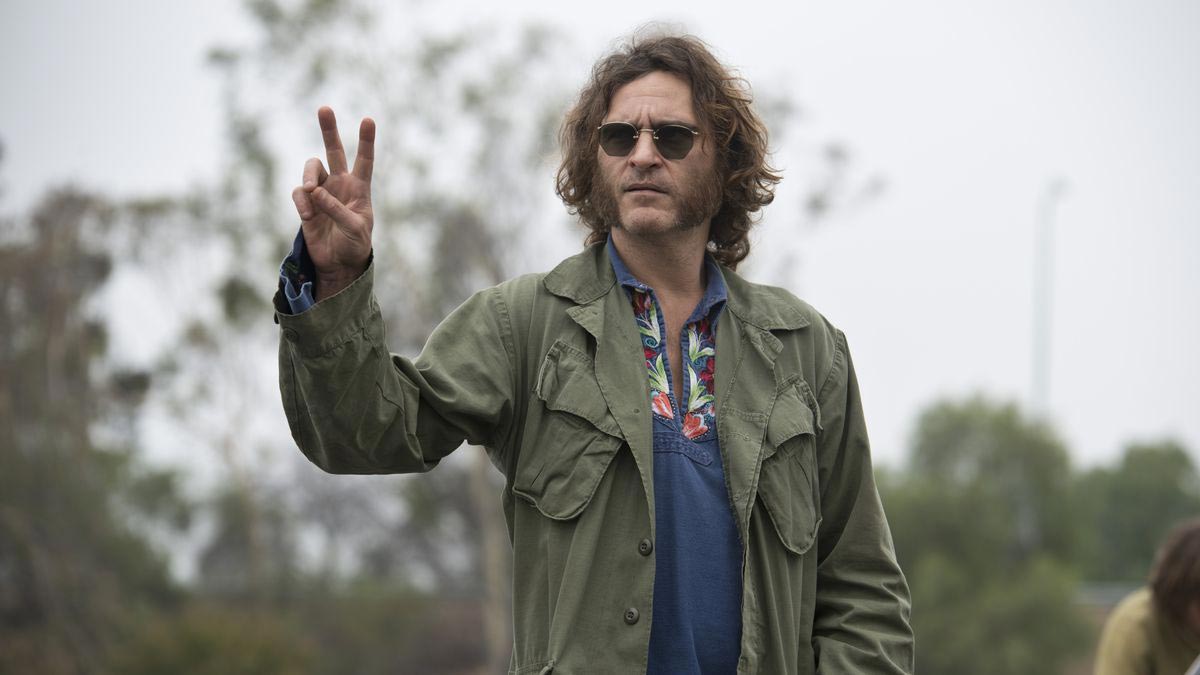
You can get overwhelmed by these complexities. You can also be exhilarated by them, the recognizable insanity (and it is recognizable, even bafflement is recognizable) of it all. Inherent Vice seeps into your soul, like the Neil Young songs and that faraway boat Doc and his maritime lawyer, the lovable Sauncho Smilax (Benicio Del Toro), are always looking at or that almost inexplicably mournful opening shot of Gordita Beach – that gap between beach pads – the light, the colors, the music (shot by Robert Elswit). Why is this is so heartachingly beautiful? The movie doesn’t so much require multiple viewings, it seduces you to revisit it, again and again, pulling you in far enough, while remaining just enough out of reach. You feel as if you need it. There are those who yearn to untangle the plot, but for me, among the many riches of watching Inherent Vice is searching to find something; something elusive, something you attempt to hold on to. But you know you’re not going to find it exactly because the movie works on an emotional current unlike any other I’ve ever seen. It’s like the first time I heard Love’s “Forever Changes” (and then listened to it over and over again), that masterful merging of haunting beauty, darkness, mystery, romanticism, crafted by a Los Angeles band who challenged any idea that the sunny Southern Californian 1967 Summer of Love was something every hippie bought into. As writer Andrew Hultkrans said of lead singer Arthur Lee: “Arthur Lee was one member of the ’60s counterculture who didn’t buy flower-power wholesale, who intuitively understood that letting the sunshine in wouldn’t instantly vaporize the world’s (or his own) dark stuff.”
By the 1970 of Inherent Vice (adapted from Thomas Pynchon’s 2009 novel), characters seem attuned to the “dark stuff” – they’re already feeling coarsened to the new decade, weaving together once heroin-addled saxophone players turned COINTELPRO informants with dental syndicates of drug cartels and Nixon and Reagan and . . . a hippie movement picked up by the establishment to exploit for monetary reasons or reasons more nefarious than that. It’s haunting and humorous, and Anderson strikes the perfect surrealistic duality/mind-melding balance (if “balance” is the right word) between the two opposing forces that are now merging into a deadened, dreamlike reality. Like secretly tortured Lt. Det. Christian F. “Bigfoot” Bjornsen (Josh Brolin)/sometimes Adam-12 TV extra and ad pitchman puts on an afro wig and hippie beads and talks youth jargon from Doc’s TV: “Hey man, I don’t want you paying rent. Rent’s a hassle. I want to see you in your own pad. The Channel View Estates, Artesia’s newest and grooviest housing development. No buzz-kill credit checks. No minimum down payments. That’s not your bag. But check this out: fully equipped kitchen with automatic self-cleaning oven and breakfast nook. Out of sight. Attached one car and available two car garage and best of all, a view of the Dominguez Flood Control Channel that can only be described in two words: Right On!” Doc freaks out a little when, in a minor hallucination, Bigfoot leans into the ad and addresses Doc personally: “What’s up, Doc?” How far away are they from each other, really? Doc could go crazy wading through all of these correlations.
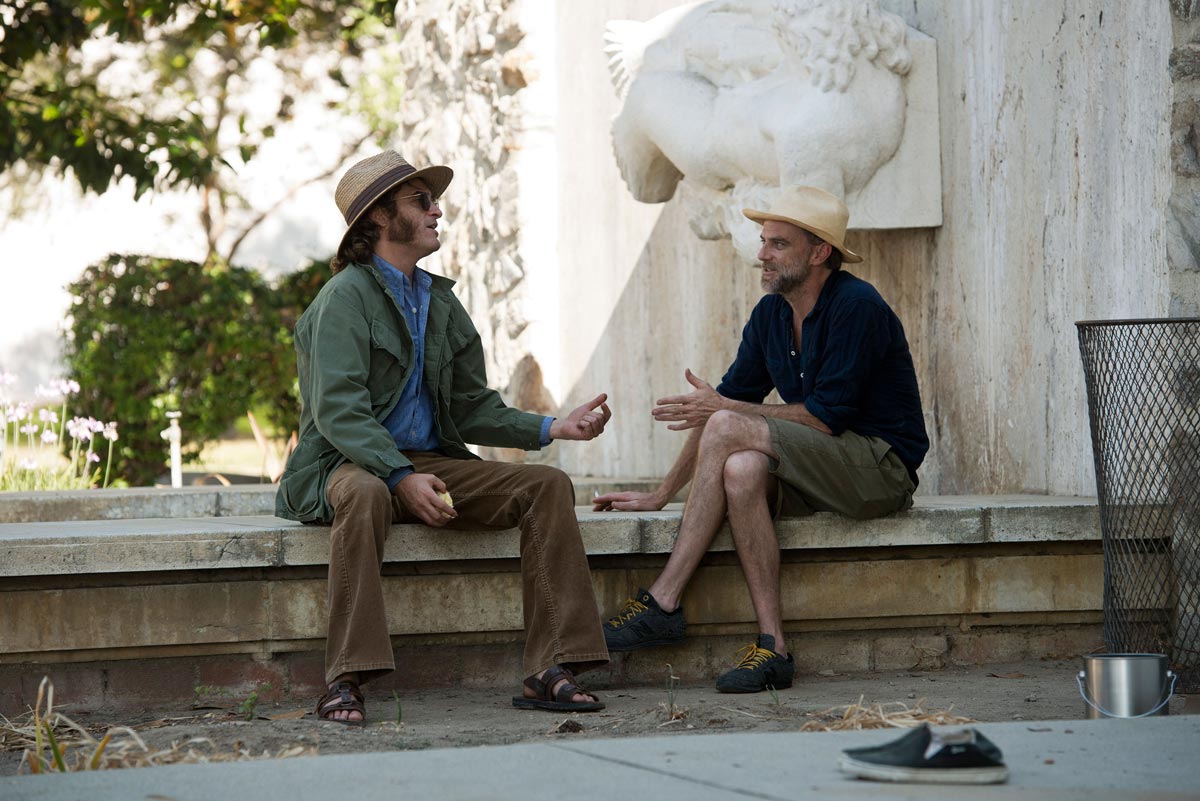 Joaquin Phoenix with director Paul Thomas Anderson
Joaquin Phoenix with director Paul Thomas Anderson
The trick (this is not really advice, just obvious common sense for the paranoid and the melancholic) is to ride out those thoughts and densely packed connections so it doesn’t choke you; like when you’re so suspicious you don’t leave the house, checking the blinds for imaginary intruders, wondering if your pot has been laced with PCP. Doc does smoke PCP, on accident, via an Aryan Brotherhood heavy (“Acid invites you through a door. PCP opens the door, shoves you through, slams it behind you and locks it.”), but he fights through the horrible high, valiantly and violently (it’s one of the picture’s many stunning scenes – watching hippie Doc utilize a firearm with an intensity and know-how and fear we’ve not seen on his face yet). And if that does happen, even without the PCP – paranoia that makes you feel as if your brain has disconnected from your body like a balloon floating off to the ocean – hopefully you can get up the next day and think about it; find reason for your freak-out. You know Doc could. Maybe that panic attack was a result of heightened sensitivity and almost extra sensory perception of something about to unfold? Some warning, whatever that is, that hasn’t found its way to you brain yet? The way dogs can sense earthquakes before everyone else does and hide under cars?
This isn’t a bad trait for a P.I., in spite of how humorous and a bit absurd the stoned gumshoe seems when set against the gimlet-drinking Philip Marlowe of the past. (Many have compared this picture to Robert Altman’s The Long Goodbye and Joel and Ethan Coen’s The Big Lebowski, and that’s apt, and Anderson discussed a host of influences, from Police Squad! to Neil Young’s Journey Through the Past to Alex Cox’s Repo Man to Quentin Tarantino’s Jackie Brown to Alfred Hitchcock’s North By Northwest, but, truly, this movie exists in its own universe) Pynchon (and the movie, too, which sticks closely to the novel with some deviations and additions, also Joanna Newsom’s Sortilège becoming a Jiminy Cricket-like narrator) calls that kind of intuition, when you sense something from your nervousness, “Doper’s ESP” (I feel like Thomas Pynchon has had more than a few illuminating anxiety attacks). Weaving throughout the various areas of Los Angeles and its sunshine suffused with an ominous undertow of darkness and corruption, Doc bumbles around on his own stoner wavelength – he’s good at his job in the way he works it. Partly, because he’s game, intrigued by various characters, surprised at times, and yet, low key. Madness doesn’t perturb him for too long, this is the sea the fish swim in, and he’s got a case to solve. Doc, who in spite of the slapstick humor and stoner indolence, is not dumb or too baked to be productive, he’s actually quite clever, and – this is key to the movie’s richness – he’s a guy who actually cares about people.

Doc is given opportunity to make spinning, divergent connections regarding his ex, Shasta Fay Hepworth (Katherine Waterston), that night she sways into his little Gordita Beach pad (serving for Pynchon’s Manhattan Beach). She’s looking beautiful but “flatland,” looking like she swore she’d never look. She’s also dragged in a dramatic entanglement and, now, a new case for Doc. In her own way, she’s back with him, but then, as they say separately, twice in the film, “of course not.” This relationship will grow ever poignant as we watch Doc remember Shasta in lyrical sequences, and we see that at its center, this is a movie about a doomed relationship. So, all of the theories, dark operations, conspiracies and period-detail gloom mix in with Doc’s sentiment and sadness towards Shasta. They divert him, and yet, they make him closer to her.
Shasta reveals that her new boyfriend, bigwig real estate developer Mickey Wolfmann (a sublime Eric Roberts), is in danger, and she’s in a position to be complicit. Mickey’s wife and her lover/spiritual coach are conspiring to throw Mickey into a loony bin, hoping Shasta will aid in their plan; get him when he’s vulnerable. She doesn’t want to. Soon enough, both Mickey and Shasta go missing. Doc’s now on it more than ever. His ex-old lady is missing, causing frequent moments of fear and lamentations, and, in his own tripped-out headspace, a quality that’s both mellow and on edge. He’s stoned but he’s alert (not all potheads are useless, this is about as stupid as people thinking they suffer Reefer Madness manias). But he does get lost in the maze a few times. In a part of Pynchon’s novel I love (which reflects the movie), circular questioning finds Doc wondering about Shasta and the web of intrigue. It riddles Doc as he smokes out with his old partner (not a character in the picture) Fritz Drybeam:
“That Mickey, known to be a generous Reagan contributor, might be active in some anti-Communist crusade came as no big surprise. But how deeply was Shasta involved? Who had arranged for her passage out of the country aboard the Golden Fang? Was it Mickey? Was it somebody else paying her off for her services in putting the snatch on Mickey? What could she have gotten into so heavy-duty that the only way out was to help set up the man she was supposed to be in love with? Bummer, man. Bumm. Er.
“Assuming she even wanted out. Maybe she really wanted to remain in whatever it was, and Mickey stood in the way of that, or maybe Shasta was seeing Sloane’s boyfriend Riggs on the side, and maybe Sloane found out and was trying to get revenge by setting Shasta up for Mickey’s murder, or maybe Mickey was jealous of Riggs and tried to have him iced only the plan misfired and whoever had contracted to do the deed showed up and by accident killed Mickey, or maybe it was on purpose because the so-far-unknown hitperson really wanted to run off with Sloane. . . .”
Doc comes to the only conclusion these obsessive kinds of thought processes yield: He exclaims: “Gahhh!” Yes, he’s really, really high. In the novel Fritz informs him that PIs should stay away from drugs. All of “‘em alternate universes just make the job that much more complicated,” he says. Doc argues that Sherlock Holmes was a good PI and he did a lot of cocaine, so, not true. His friend tells him Sherlock Holmes wasn’t a real guy. Doc disagrees: “No, he’s real. He lives at this real address in London. Well, maybe not anymore, it was years ago, he has to be dead by now.” Freak-out over. Digressions can really calm a person down.
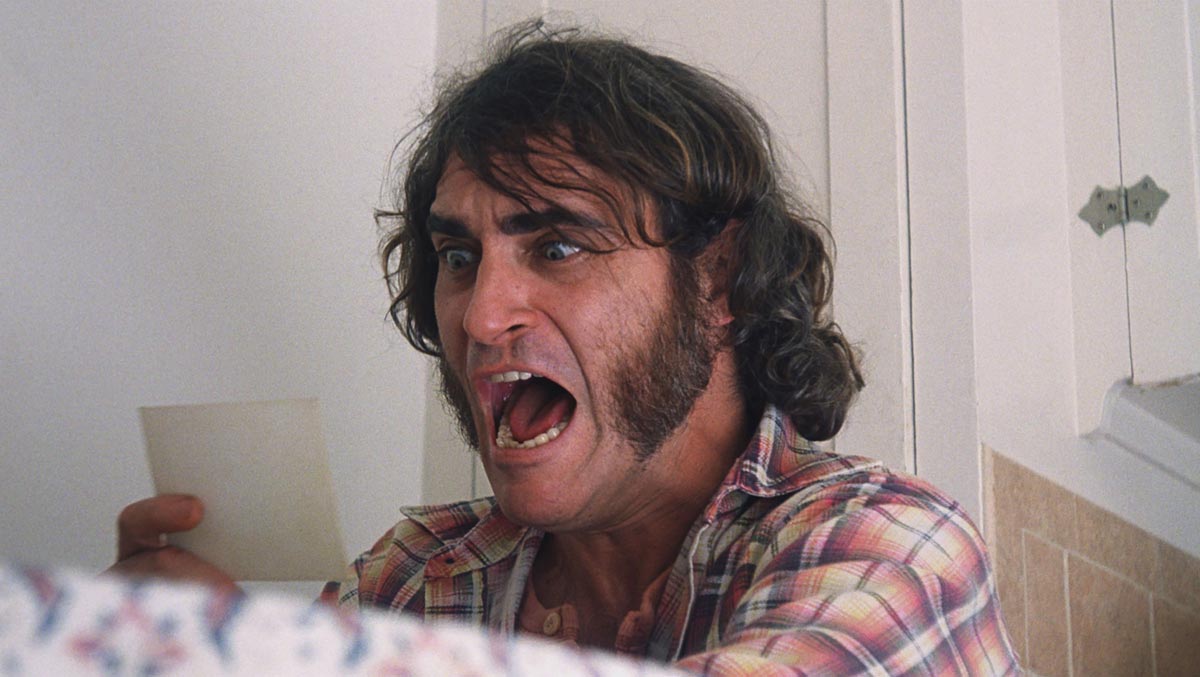
And the picture’s digressions (for there are many, wonderfully so) present a collection of characters whom Doc encounters with confusion, suspicion, fear, lust, fondness, empathy . . . so many various expressions. These disparate personalities, oddball, touching, sexy, terrifying or merely baffling, serve the detective story well, but they also add texture and depth to both the movie and to Doc. Part of Inherent Vice’s power is watching a brilliant Phoenix’s sensitive and mischievous face observing a person. His expressive blue eyes really study people, even when he’s supremely stoned. From Jade (a charming Hong Chau), who’s like the Joan Blondell of the movie; to prim-but-not-so-prim, kind-of girlfriend Deputy D.A. Penny Kimball (Reese Witherspoon); to his brief scene with Roberts’ Mickey in which Doc (and the audience) take in this man’s haunted face, moving from a weird “Hello little hippie” sweetness to expressing, nearly every poignantly tragic moment in the movie with just a few powerful close-ups of his face (my god, it’s lovely to see Eric Roberts on screen like that); to the way Doc kindly listens and nods as Hope Harligen (Jena Malone) describes her seedy meet-cute with her missing husband, Coy (Owen Wilson), handing Doc a graphic photo of their baby, which makes him quickly, hilariously, yell aloud, and then swiftly compose himself.
Another remarkably mixed mood moment is Doc’s dinner with Crocker Fenway (Martin Donovan), the wealthy, sneering snob who rewards Doc for saving his teenage daughter from demented dentist, Rudy Blatnoyd (Martin Short coming off like Austin Powers’ degenerate uncle and a touch of Phil Spector). Doc, dressed his best (that turquoise necklace) listens to Fenway detailing, with horror, the transgressions his daughter endured, and not all because of sex, but because of Blatnoyd’s tackiness (“The wallpaper. The lamps” – if you’ve ever wondered how a person could perfectly describe disdain for lamps, Donovan will quell your curiosity). Doc’s attempting to be both nice and tough, but Fenway insults him. The various expressions flickering on Doc’s face makes you feel for him in general (you feel for Doc a lot in this movie), but also feel (and this is without condescension) proud when he sticks up for himself: “I may not be as well connected, and for sure not as much into revenge as you folks are. But if you jive with me, my man. I say to you . . .” and he makes a click click sound. I love that sound he makes. It’s disarmingly touching.
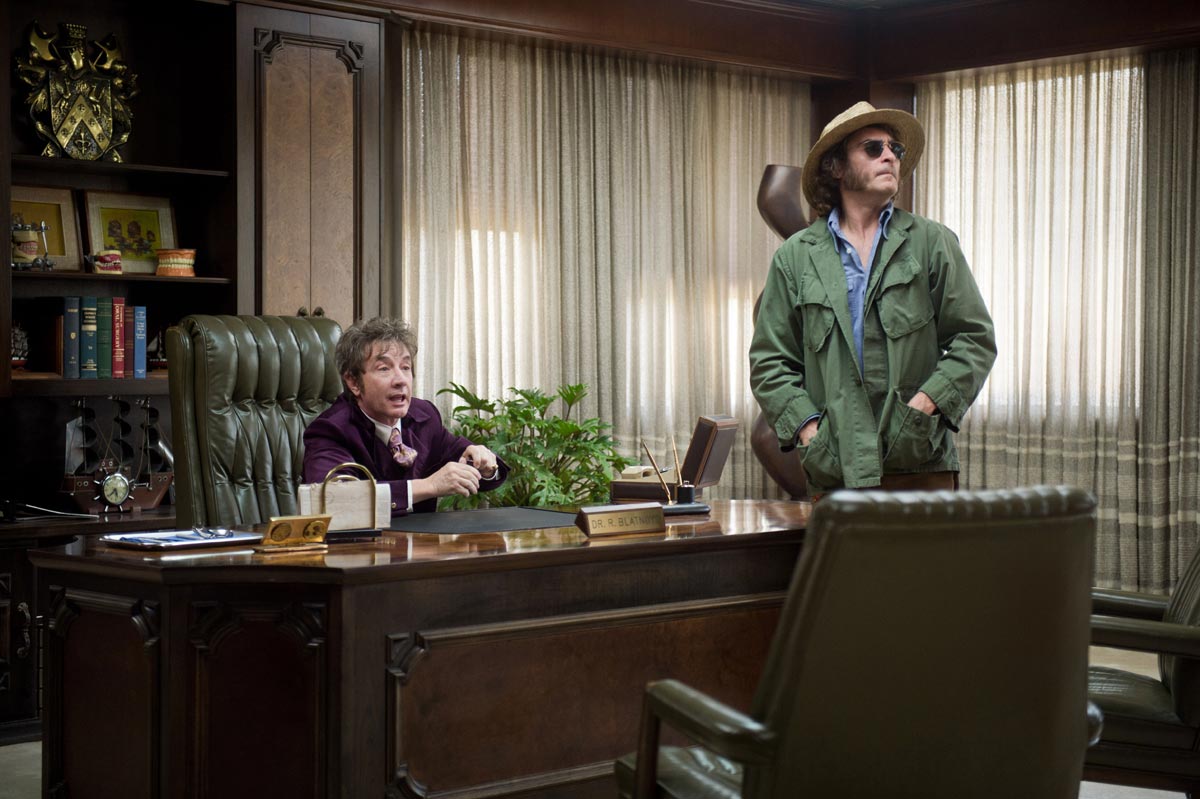
Doc’s relationship with Shasta is like a simultaneous love and ghost story. Often she appears like an idealized dream, the way we frequently remember those we pine for, forgetting the bad times. A flashback of the two running through the rain to Neil Young’s “Journey Through the Past” is so overwhelming romantic and stirring that it feels personal, like even personal to the viewer (who hasn’t had this kind of idyllic memory come to them before? Who wouldn’t want to return right back to that perfect feeling?). Things become, perhaps, real (in a still dreamy sense) in a powerful extended scene in which Doc has angry/emotional sexual encounter with Shasta. She sits naked detailing what Mickey made her do – is she taunting him? Expressing sadness and trauma? Is she getting off on it? It could be all things, and not because she’s a “femme fatale” or a bad person, or merely fucking with him, it’s much more nuanced than that. And so is Doc’s response. This scene’s been deemed controversial by some, a male fantasy even, but that takes away all of its complexity and rawness, for both Doc and Shasta. It’s an extraordinarily thorny moment, between two people who really know one another. It’s supposed to be discomforting and sad and emotionally honest. You’re supposed to think about it. It also shows that their relationship is more complicated than his idealizations.
An entire separate essay could detail the relationship between Doc and the hilariously severe, incredibly damaged Bigfoot (“Like a bad luck planet in today’s horoscope, here’s the old, hippie-hating mad dog himself . . . SAG member, John Wayne walk, flat top of Flintstones proportion, and that little evil shit twinkle in his eye that says, civil rights violations.”) The interplay between Phoenix and Brolin (who is extraordinary) is so exquisitely timed, from big moments to seemingly throwaway lines (nothing is throwaway here), that their connection takes on a plaintive depth that builds and builds until, you are taken aback by how moved you are (and you really start to like Bigfoot). When Doc realizes that his nemesis and, in a strange way, his ally, is mourning the death of his partner (who he was probably in love with) Bigfoot’s actions attain a more dejectedly distressed meaning. His anger and chocolate covered banana sucking and yearning for respect shows a man who is on the edge of, likely, a complete nervous breakdown. The man who berates Doc constantly and who stomps on him (literally), and who puffs up his chest and yells “Molto Pan-a-cake-o!” is, in fact, the saddest character in the movie. By the time he eats a plate of marijuana, lamenting that Doc’s not come around after the case is closed, tears stream down Doc’s face. You’re stunned by what Bigfoot’s doing, and then, my god, are you moved. Doc asks: “Are you OK, brother?” Bigfoot answers: “I’m not your brother.” Ever empathetic Doc replies: “Yeah, but you could use a keeper.”
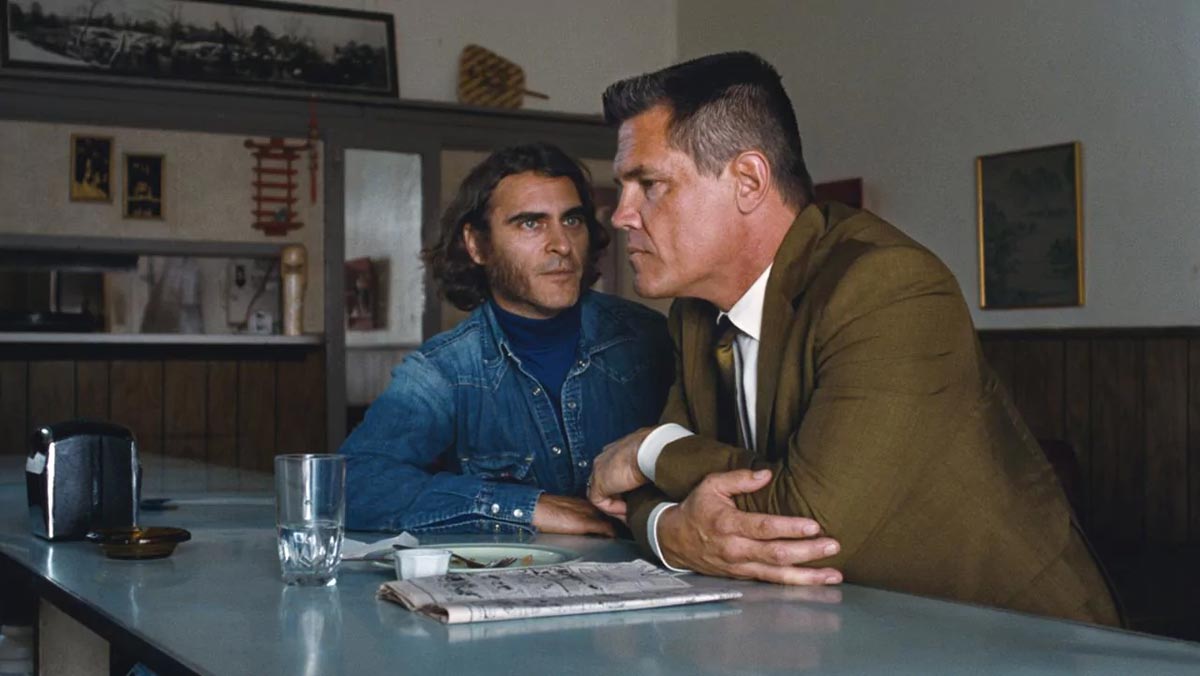
These characters will have more rabbit holes to dive down, but the case is over, and rather than rejoice, there’s a sadness that ends the picture with a . . . what now? As Sortilège narrates: “Yet there is no avoiding time, the sea of time, the sea of memory and forgetfulness, the years of promise, gone and unrecoverable, of the land almost allowed to claim its better destiny, only to have the claim jumped by evildoers known all too well, and taken instead and held hostage to the future we must live in now forever.” That’s why we like to whirl with endless conspiracies because, well, they often never end.
The one bit of closure has a poignantly heroic Doc saving Coy and dropping him off to his wife. But while you’re happy for Coy, the camera lingers on Doc’s bittersweet, forlorn face sitting in his car as Jonny Greenwood’s gorgeously melancholic score underscores the emotion. Nothing is wrapped up for him. Even when he’s driving off with Shasta, nothing is for certain. Who knows what’s in store? Who knows if it’s really even happening? Should we attempt to figure it out? “Of course not.”


